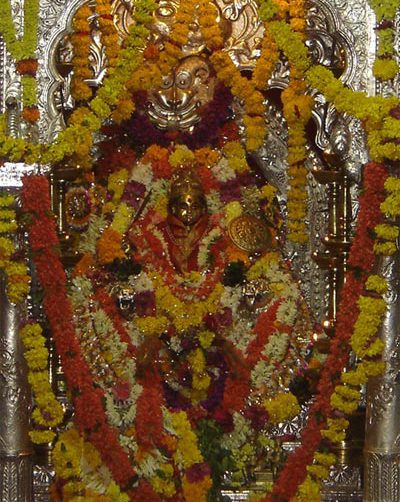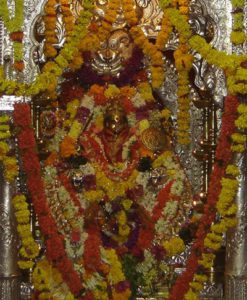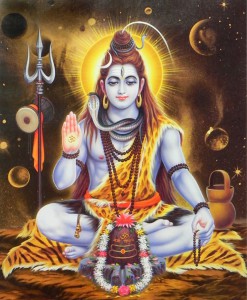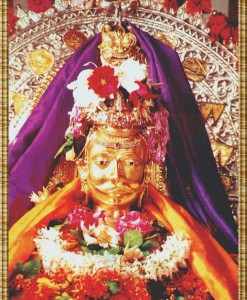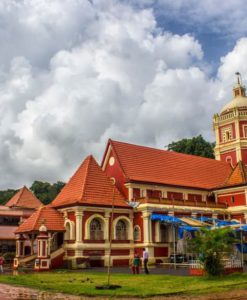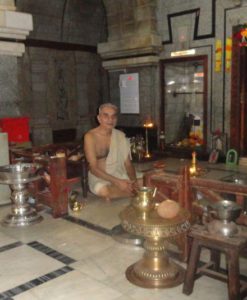No products in the cart.
Mahamaya Kalika Devasthan, Kasarpal
Mahamaya Kalika Devasthan is a temple complex in Kasarpal village of Bicholim taluka in the state of Goa, India. The presiding deity of the temple is Kali, worshipped in the form of Mahamaya. The goddess Kali, the terrible and cruel, is worshiped with blood sacrifice in most parts of India, in Goa however the fierce invocation of the deity was never popular. As per folk myths after killing the demons Sumbha and Nisumbha, the deity’s anger was soothed and the deity manifested herself in a peaceful (Shanta), gentle (Soumya) form, which is very popular in Goa.
The myths concerning Kali worship derive from at least three different sources. In the Linga-purana Lord Shiva asks Goddess Parvati to destroy the demon Daruka, who had been given the boon that he can only be killed by a female. Parvati then enters Lord Shiva’s body and transforms herself from the poison that is stored in Lord Shiva’s throat. She reappears as Kali, ferocious in appearance, and with the help of flesh eating pisacas (spirits), attacks and defeats Daruka and his hosts. The Kalika Purana, describes her as Shiva’s consort and so do several other Tantric texts. On the other hand, According to the Devi Mahatmyam, she is a minor emanation from the angry third eye of the goddess during her battle with the demon hosts of Sumbha and Nisumbha. With her lolling tongue, her role was to lick up every drop of blood of the demon general Raktavija, for otherwise each drop would produce countless clones. She was created as Kaal Bhoy Naashini (destructor of fear) to save the heaven and earth from the growing cruelty of the demons. She set on her way to end the war and kills the devils.
With a tremendous stress of war, Kali enters Gomantak (Goa) in order to take rest along with Dakini and Jogini, Her two escorts. Kali takes up residence in a forest thatched hut with abundant water source and which is known today as Kasarpal. After the great dissolution of the world, she regenerates by shedding her fearful appearance and enters into intimate bond of love between the Divine Mother and her human children with a unique relationship. In this relationship, the worshipper becomes a child and Maa Kali assumes the form of the ever-caring mother, Shree Mahamaya Kalika. The goddess whose victory is thus celebrated is Mahamaya, the grand illusion which makes desire for possessions and procreation the innate quality of human beings and is thus responsible for the unsatisfactory and transient nature of this life.
She is the Maha Shakti at the back of Her every manifestation. She is the Brahma Shakti manifested to us through the form of Saraswati. She is Vishnu Shakti manifested to us through the form of Lakshmi. She is also Shiva Shakti manifested to us through the form of Parvati. Shree Mahamaya Kalika is the combination of both Vidya and Avidya in Her supreme form. As the symbol of Avidya, She is omnipresent in the form of Cosmic delusion. And, at the same time as the symbol of Vidya, She is adored as the supreme force of cosmic deliverance, leading the Jiva from the mysterious spiritual deliverance to spiritual wisdom.
The concept of worshipping Shree Mahamaya Kalika is not of recent origin. It was in vogue in the ancient past. Legend records the great poet Kalidasa visited this temple which inspired him to create the great epic ‘Meghdoot’. Shree Mahamaya Kalika is worshipped by one and all irrespective of any distinction and bestows the mystic blessing. She exists in form of potent divinity. Devotees regularly visiting this temple are mostly Daivadnya Brahmins. The Goddess Mahamaya Kalika is also the Isht Devta (tutelary deity) of all Daivadnya Brahmins and pay homage to the Goddess and provide their services to the temple.
Shree Mahamaya Kalika temple of Kasarpal is one of the most important Hindu monuments in North Goa situated at a distance of 18 Kilometers from Mapusa. Temple finds a place in any Goa temples travel plan due to a huge gold Kalash (vessel) on the dome of the temple, unique structure and its fine blend of aesthetics and architectural designs. Temple committee offers the resort for the devotees from all over the country and equally appealing to the foreigners who take back some of the rare and the most cherished moments of their life thus making their trip most perfect one.
The Mahamaya Kalika Devasthan is a masterpiece of Goan temple architecture, with a huge hall for public gatherings during festivals and meetings (Sabhamantapa a stage and aNagarkhana which is above the stage is used to play drums and shehnai during specific times of the day and during specific rituals), the main hall inside the temple (Chowk), path for circumambulation (Sarwali) and Sanctum sanctorum(Garbhakud or Garbhagruha), with a huge golden Kalasha. Temple is surrounded by Agrashalas, two beautiful gates (Praveshdwaras) and a magnificent lamp tower (Deepastambha) is eye-catching.
The main idol in the sanctum sanctorum is more than 800 years old and is a masterpiece of Kadamba sculptures. The deity is four armed, shows each hand carrying variously a sword(Khadga), a trident (trishul), a Shield(Khetaka) and a skull bowl (Kapala), her mount lion, can be seen at her feet.
The temple Panchishta includes the following deities: Devi Panchayatana (worshiped in the main sanctum sanctorum, includes Shivalinga, Shaligrama etc.), Ravalnath, Hedgeshwar, Shetyeshwar, Palnath. A Buddhist idol of Shakyamuni is found in the temple, as a remnant of the Buddhist sect that prevailed in Goa till the early 12th century AD.
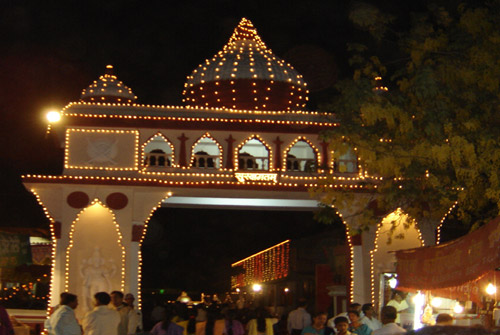
By Road: The Mahamaya Kalika Devasthan is situated in Kasarpal village in Bicholim taluka of Goa in Indian Territory. KSRTC runs bus services to this temple. One can also reach this temple by hiring a taxi.
By Rail: The nearest railway station present to the temple is Karmali Railway Station.
By Air: The nearest airport present is Panaji Airport.
Mahamaya Kalika Devasthan, Kasarpal
The opening and closing time of the temple are: 5:00 AM to 10:00 PM. Here daily rituals of Goddess Kali are performed.
The Shishirotsav of Kasarpal temple attracts pilgrims from Goa, Maharashtra and Karnataka. It is a 10-day-long celebration, includes procession of deities in differentVahanas, and various other rites like Ganga Pujan, Homa, Dhwajarohana, Gulalotsava, Rathotsava etc.
An orchestra known as Suvari is played during the festival which includes musical instruments Ghumot, Kasale, cymbals and Shehnai. Other important festivals are Ratha Saptami, Navaratri, Vasant Puja, Akshay Tritiya, Dasara, Avali Bhojan. Silver Palanquin procession of the deity on every Chaturdashi of the dark fortnight of Hindu lunar calendar is also a major attraction.
[/tab]
[/tabgroup]

